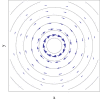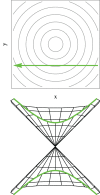Non-adiabatic dynamics close to conical intersections and the surface hopping perspective
- PMID: 25485263
- PMCID: PMC4240175
- DOI: 10.3389/fchem.2014.00097
Non-adiabatic dynamics close to conical intersections and the surface hopping perspective
Abstract
Conical intersections play a major role in the current understanding of electronic de-excitation in polyatomic molecules, and thus in the description of photochemistry and photophysics of molecular systems. This article reviews aspects of the basic theory underlying the description of non-adiabatic transitions at conical intersections, with particular emphasis on the important case when the dynamics of the nuclei are treated classically. Within this classical nuclear motion framework, the main aspects of the surface hopping methodology in the conical intersection context are presented. The emerging picture from this treatment is that of electronic transitions around conical intersections dominated by the interplay of the nuclear velocity and the derivative non-adiabatic coupling vector field.
Keywords: Born-Oppenheimer approximation; Landau-Zener; conical intersections; decoherence; non-adiabatic dynamics; surface hopping.
Figures








References
-
- Abramowitz M., Stegun I. (eds.). (1972). Handbook of Mathematical Functions. New York, NY: Dover.
-
- Alijah A., Nikitin E. E. (1999). Fast quantum, semiclassical and classical dynamics near the conical intersection. Mol. Phys. 96, 1399–1410 10.1080/00268979909483084 - DOI
-
- Arfken G. B., Weber H. J. (2005). Mathematical Methods for Physicists, 6th Edn. Boston, MA: Elsevier Academic Press.
-
- Atchity G. J., Xantheas S. S., Ruedenberg K. (1991). Potential energy surfaces near intersections. J. Chem. Phys. 95, 1862–1876 10.1063/1.461036 - DOI
-
- Baer M. (2006). Beyond Born-Oppenheimer: Conical Intersections and Electronic Nonadiabatic Coupling Terms. Hoboken, NJ: Wiley-Interscience; 10.1002/0471780081 - DOI
Publication types
LinkOut - more resources
Full Text Sources
Other Literature Sources

